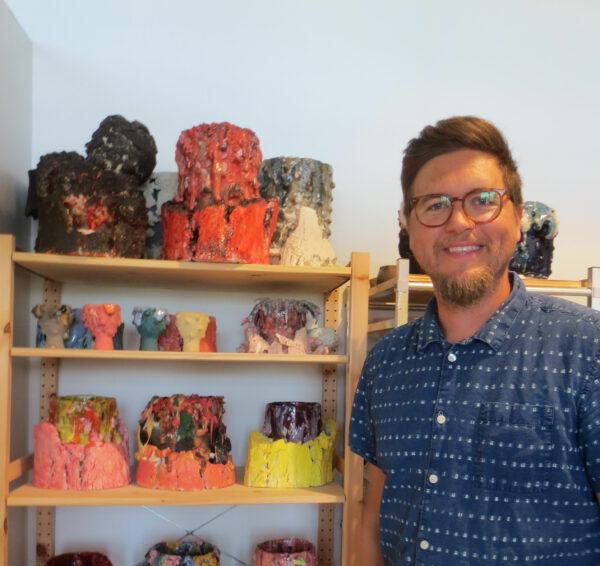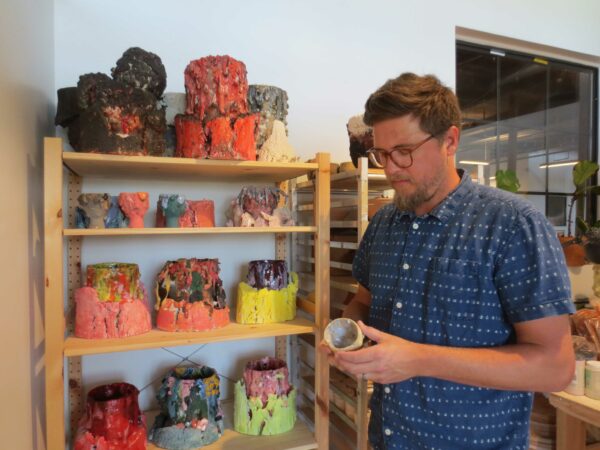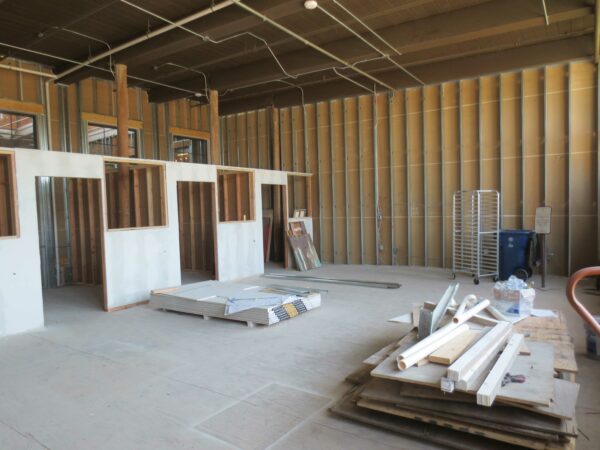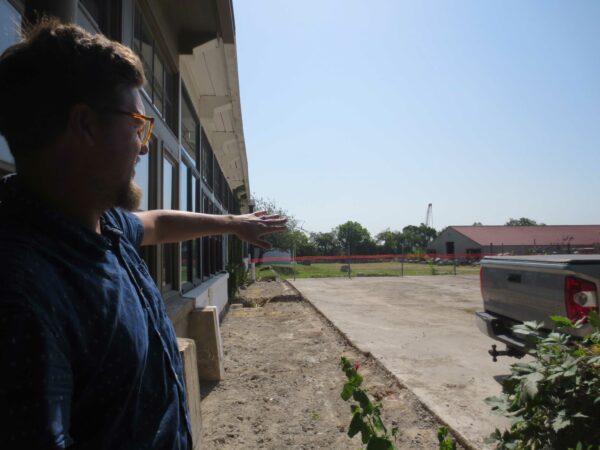Skilled artists often find that they need to create the opportunities that other career pathways already have built in place. Adam Knoche and his wife, Angie Knoche, spoke for over a decade about creating a place to make. During the tail-end of the pandemic, the couple decided to move forward and find a way to build the community ceramics studio they had always talked about, Glaze Ceramic Studio.
“We’ve always wanted to start a business together, but the timing never seemed to work out. We were either finishing school, moving, or working (sometimes multiple) jobs that we did not love, and then we had three children. I think COVID really pushed us to take the leap because we were craving that community and feeling like we wanted to do something more with our lives,” says Angie.
Adam and Angie have based the business model of Glaze Ceramic Studio around a working model in New York, called Greenwich House Pottery, which began in 1904. The classes and studio operations are designed so any student can progress to gain full mastery of the craft. Adam joined Greenwich House Pottery after graduating with his MFA. He speaks highly of his time working there and the collaborations across art forms the space encouraged. Greenwich House ceramics focus both on functionality of vessels and on sculpture in contemporary art. Greenwich invites artists, proficient in their own mediums, to create new work at residencies that are guided by the staff, which for a stint included Adam.
The Greenwich House Pottery model includes expert instruction in the process of working in clay to beginning students, and progresses the students up to become independent in making. Finally, students who are working independently, those that Adam refers to as “production potters,” are vetted can lease studio spaces within the larger classroom. Glaze Studio also offers workshops in special topics, bringing beginners and expert artists together in one space of making.
Adam manages the daily operations of Glaze Ceramic Studio. “We started getting traction pretty quick. We had all the [private] studios rented out before we even opened. I just had to make up the difference. We had a full class for the first class. And I was teaching everything in the morning and the evening. Mopping the floors and cleaning up. I was teaching three of the four classes. I did that for nine months before we hired the first teacher,” says Adam.
Since opening, on July 25, 2022, Adam has been able to hire four instructors and two kiln technicians, each with an extensive background in ceramics. Adam extends the studio out to working artists, who are invited to teach workshops, giving them and their work more exposure. His hope is to take beginning community members who walk in the door with no knowledge of ceramics and coach them toward becoming proficient studio artists.
Glaze Ceramic Studio is different from other ceramics studios in the North Texas area in that it is made available 24/7 to members. The model has enabled many artists and working adults the necessary space and time to work in ceramics; trust and community building have made this possible. “People (especially now) are hungry for ways to create. This very tactile medium helps people in so many ways…it forces them to unplug, to slow down, and to go with the flow,” says Angie.
Even with an all-access studio, Adam sees a need for more access and instructional space. The studio is already expanding into an adjoining space. “1,500 square feet will be for studio artists; the current space of 2,300 square feet will become dedicated for community classes. The space next door will allow us to have a class, while [members and studio artists] can work next door continuously, without being interrupted,” says Adam.
Students progress through tiers with the support of instructors and advanced students. The tiers are based on the Greenwich House model, with the idea that a student will eventually become an independent artist. Community students take introductory classes; the next tier is a membership, where students gain more access to the studio and can take advanced classes. Finally, members who have begun to work at a production level can rent private studio spaces. The private studios rentees are vetted by Adam and awarded to students he sees as being ready to operate independently as ceramic artists.
“When I was teaching I couldn’t find any studio spaces that were affordable. How do you make this work financially? Also, my students, how do you tell them? You need to go here and get a studio? You need to get your next education, but that’s not really setting anybody up to be a studio artist. This came about mostly from having a place for people to work outside of graduating from school, and to get the community to come here and have people interested in hobby ceramics and to educate them, but give them a good education,” says Adam.
Adam and Angie will tell you it is frustrating to try to find any studio space that is affordable, but the nine-month-long search to find a place to start their small business was an exhausting, daily undertaking. While they had a workable model from Greenwich House Pottery, it was the cost of retail space and sticky commercial leases that were daunting and had the couple worried it may never happen.
“[W]e moved to McKinney and had decided to pursue our dream of opening a ceramic studio. Adam went by the Cotton Mill one day to see what was going on inside the building…that’s when he met the owner, Terry Casey. Terry was very excited about the idea of bringing a ceramics studio to the Cotton Mill, as he was already providing studio spaces for other artists such as painters, photographers, and printmakers,” says Angie.
The Cotton Mill has been run by the Casey family since 1996. The building was built in the 1880s and did in fact serve as a cotton mill. The Casey family focuses on placing artists and creatives in the building, and believe that creatives drive community and innovation. The Cotton Mill feels vast, with some corners occupied and finished out, while other wings of the building remain unoccupied. “I thought this building was abandoned at first. It looks like the ancient ruins of McKinney, but I came in here and there were already people here, working and thriving,” says Adam. The Cotton Mill is being methodically transformed to meet the needs of the local artists. The ongoing process of filling the building with occupants has generated many shared studio spaces, as well as an entire wing dedicated to small, art-based businesses run by women.
“Glaze Ceramic Studio was our first leap into a more retail-oriented business and we couldn’t be happier with the result. When we first met [Angie and Adam], we were skeptical just because we hadn’t had a business like theirs in our building before. We have always had artists and designers here, but since Glaze’s inception we have now been able to take larger leaps into [other] retail and creative fields, like in the Coffee Shop we have just opened and a music recording studio that we hope to have open in 2024,” says Chandler Casey, Manager of the Cotton Mill.
The proximity to other artists has already benefited Glaze Ceramic Studio. According to Adam, “Being a part of the [Cotton Mill] and collaborating with people is really important to the community. When you’re in academics, [students] are all in different areas and don’t talk to each other. So, you don’t get the opportunity to [collaborate] unless it’s forced. I think having a space like the [Cotton Mill] offers opportunity, because you do have other people who are doing creative things and who can come together and have that understanding of collaboration, or curiosity.”
Adam and Angie are working to continue to build the community around Glaze Ceramic Studio by adding a kiln yard. The Knoches want to bring more experiences and opportunities to the students and locals by sharing traditional firing processes that can last days. Adam speaks of the authentic human experience of working together to accomplish a difficult task of keeping the kiln burning, feeding the fire and bonding over the work involved. Adam can point to the area in the yard where he knows his kiln will be built. It’s just a matter of time before Glaze Ceramic Studio expands again.






